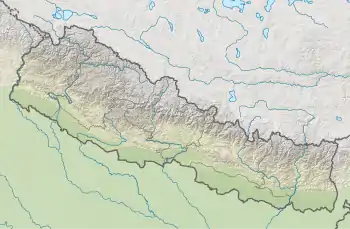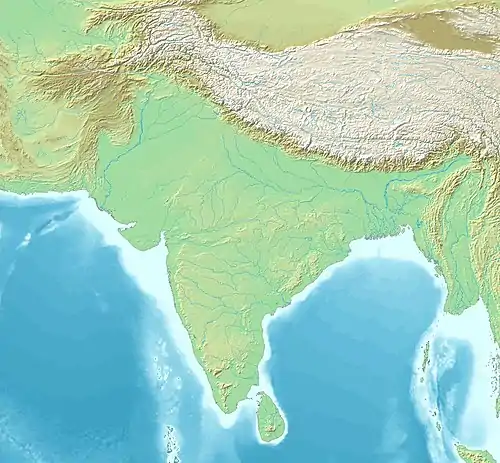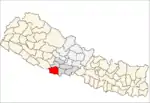Tilaurakot
Tilaurakot is a village development committee in Kapilvastu District in the Lumbini Zone of southern Nepal. At the time of the 1991 Nepal census it had a population of 5684 people living in 944 individual households.[1] It might have been the cardinal point of the ancient Shakyan city of Kapilavastu, where Gautama Buddha spent 29 years of his lifetime. It is situated west of Lumbini Grove, traditionally held to be the birthplace of Gautama Buddha. The site was listed as a UNESCO tentative site in 1996 by the Nepalese government.[2]
Tilaurakot
तिलौराकोट | |
|---|---|
 The east gate at the Tilaurakot archaeological site. | |
 Tilaurakot Location in Nepal  Tilaurakot Tilaurakot (South Asia) | |
| Coordinates: 27.58°N 83.08°E | |
| Country | |
| Zone | Lumbini Zone |
| Province | Province No. 5 |
| District | Kapilvastu District |
| Population (1991) | |
| • Total | 5,684 |
| Time zone | UTC+5:45 (Nepal Time) |
History
The 19th-century search for the historical site of Kapilavastu followed the accounts left by Faxian and later by Xuanzang, who were Chinese Buddhist monks who made early pilgrimages to the site.[3][4][5][6] Some archaeologists have identified the Tilaurakot archeological site as the location for the historical site of Kapilavastu,[7] while others claim it was 16 km away at Piprahwa in the Indian state of Uttar Pradesh.[8][9]
Tilaurakot was discovered by PC Mukherji in 1899 tracing the journey of those two Chinese monks following the history, they were visited Tilaurakot in the 3rd and 6th centuries AD. Archeologists believe that it was the civic center from 9th century BC to 3rd Century AD. Experts have discovered the palaces, temples, monuments, sculptures, ponds, roads and it has already proved that the place was the capital of Shakya Kingdom and home town of Buddha. Some of the objects found during the excavation are kept in Kapilvastu Museum near the Tilaurakot which is being displayed for the visitors.
UNESCO Tentative Listed Site
Archaeological excavation is still going on as of now at Tilaurakot but it has already proved that Tilaurakot was the ancient palace of King Suddhodhana, father of Buddha. Three palaces are already explored by excavation and other palaces are under excavation which will discover more parts of the entire city and many more of Art, Architecture, life, and the pride of the ancestors. Furthermore, all the concerned parties are hoping this final excavation will help getting listed on the UNESCO World Heritage Sites as it was already listed as a UNESCO tentative site in 1996 by the Nepalese government.
References
- "Nepal Census 2001". Nepal's Village Development Committees. Digital Himalaya. Retrieved 14 December 2008.
- https://whc.unesco.org/en/statesparties/np
- Beal, Samuel (1884). Si-Yu-Ki: Buddhist Records of the Western World, by Hiuen Tsiang. 2 vols. Translated by Samuel Beal. London. 1884. Reprint: Delhi. Oriental Books Reprint Corporation. 1969. Volume 1
- Beal, Samuel, trans. (1911). The Life of Hiuen-Tsiang. Translated from the Chinese of Shaman (monk) Hwui Li. London. Reprint Munshiram Manoharlal, New Delhi. 1973.
- Li, Rongxi (translator) (1995). The Great Tang Dynasty Record of the Western Regions. Numata Center for Buddhist Translation and Research. Berkeley, California. ISBN 1-886439-02-8
- Watters, Thomas (1904). On Yuan Chwang's Travels in India, 629-645 A.D. Volume1. Royal Asiatic Society, London.
- Tuladhar, Swoyambhu D. (November 2002), "The Ancient City of Kapilvastu - Revisited" (PDF), Ancient Nepal (151): 1–7
- Srivastava, KM (1980). "Archaeological Excavations at Piprāhwā and Ganwaria and the Identification of Kapilavastu". The Journal of the International Association of Buddhist Studies. 13 (1): 103–10.
- "Shailvee Sharda (May 4, 2015). UP's Piprahwa is Buddha's Kapilvastu? Times of India".
Further reading
- Davis, C. E. et al. (2016). Re-investigating Tilaurakot’s Ancient Fortifications: A Preliminary Report of Excavations Through the Northern Rampart of Tilaurakot. Ancient Nepal 190, 30-46

